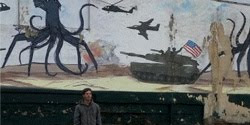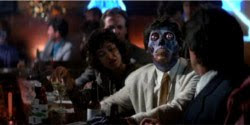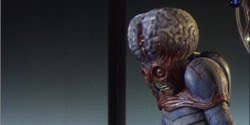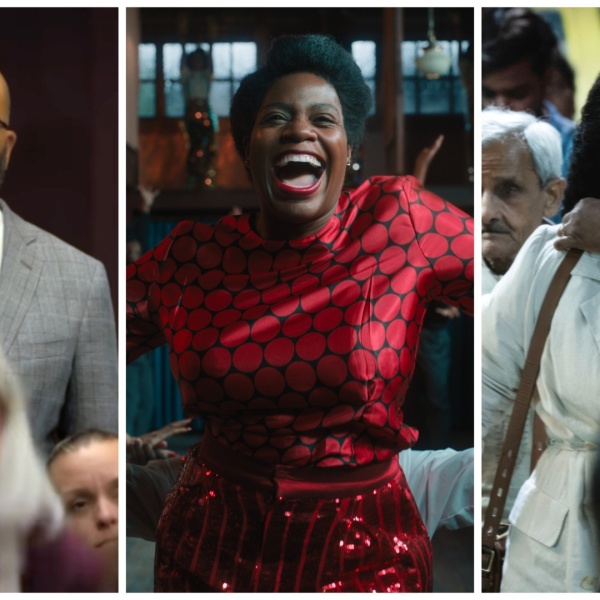
While the genre never really goes away, once a decade or so the alien invasion picture suddenly hits the zeitgeist. It happened in the 1950s with the slew of B-movies, it happened in the 1990s as “The X-Files” captured the public’s imagination, and for whatever reason (birthers? immigration concerns? a shortage of fake teeth for vampire movies?) it’s happening again now.
Last November saw “Skyline” start to broach the subject in a big way, hot on the heels of the surprise hit “District 9,” and the coming weeks and months sees Greg Mottola‘s comedy “Paul,” Joe Cornish‘s much-buzzed-about “Attack the Block,” the western hybrid “Cowboys & Aliens” and the Russian-set actioner “The Darkest Hour” hitting theaters. But first up, unfortunately, is “Battle: Los Angeles” which, as our review from yesterday will attest, is one of the more painful theatrical experiences in recent memory.
Fortunately, there’s plenty of far superior pictures dealing with the same subject matter in a much more watchable manner, so we’ve delved into the archives to pick out a selection of seminal movies featuring alien aggressors that will make you feel something other than a fear of “Clash of the Titans 2” and concern for Aaron Eckhart‘s career.
 “The Blob” (1958)
“The Blob” (1958)
There are twin invasions present in the 1958 “The Blob,” and both signify a direct threat to the good townspeople — both the amorphous alien menace and… the emergence of teenagers (led by Steve McQueen). Authorities don’t believe the kids when they say that a blobby bit of galactic goo has started to eat people and grow in size. But then, of course, they figure it out too late (about the time it takes up an entire movie theater). “The Blob” is a quaint, easy-going drive-in movie that probably won’t scare you today but is still likely to make you smile. It should also be noted that Frank Darabont and Chuck Russell crafted a sturdy remake in the late ’80s that upped the gore quotient with elaborate special effects but retained the rebellious teens-versus-small town authority core that made the original so indelible. [B]
 “Independence Day” (1996)
“Independence Day” (1996)
Fiercely nationalistic, casually racist, and embarrassingly entertaining, Roland Emmerich’s “Independence Day” could be B-moviemaking at its silly best. An army of “that guys”–and some genuine stars like Will Smith and Jeff Goldblum–take on the invading hordes and (spoiler alert) win, as the whole world waits for America to save the day on the Fourth of July. It’s easy to be sarcastic about this bombastic, over-the-top blockbuster with a blush-inducing St. Crispin’s Day speech delivered by the president (Bill Pullman), but it’s far easier to just have fun and enjoy the effects-driven ride. But as much as the city-sized UFOs and telepathic aliens push the story toward its gleefully inevitable conclusion, Smith’s charm is what makes it all watchable over a decade later. [B]
 “Invasion of the Body Snatchers” (1956)
“Invasion of the Body Snatchers” (1956)
The “Citizen Kane” of 1950s science fiction films, the original “Invasion of the Body Snatchers” is still the best. Based on the Jack Finney novel “The Body Snatchers,” the story should be familiar to anyone semi-literate in film. It centers on a doctor (Kevin McCarthy) whose patients insist their loved ones have been replaced by imposters. It appears that people are being replaced by perfect duplicates grown in pods who are identical to their human counterparts but lack all emotion. Widely seen as an indictment of McCarthyism, the film works as both paranoid thriller and political allegory (the best ones usually do.) Watching the film today, it’s amazing to see the way this movie walks the line between many genres (noir, sci-fi, horror) without ever stepping into silliness. Despite the opening/closing bookends shoehorned onto the film by the studio, the ending (featuring one of the best examples of breaking the 4th wall in cinema history) is still chilling. “They’re here already! You’re next!” A true classic. [A]
 “Lifeforce” (1985)
“Lifeforce” (1985)
Most alien invasion movies are defined by flying discs, but Tobe Hooper‘s “Lifeforce” is most fondly remembered for a pair of orbs — namely, the breasts of lead actress Mathilda May, who spends most of the movie walking around completely naked. The production, which was co-written by “Alien“‘s Dan O’Bannon, infamously ran over-budget and was marred by disagreements in the editing room between Hooper and his production company, the dearly departed Cannon. Not that this explains anything you see onscreen. The movie has some bright spots, for sure, including a typically jaunty Henry Mancini score and an admirable lead performance by the underrated Steve Railsback, but it’s mostly a mess — an unintelligible mishmash involving space vampires, Haley’s Comet, and lots of hot alien nudity. Even Hooper’s considerable stylistic flourishes can’t save this from being little more than a late night oddity. [B-]
 “Mars Attacks!” (1996)
“Mars Attacks!” (1996)
The cinematic landscape in 1996 was punctuated by a pair of big budget, heavily hyped alien invasion movies. “Independence Day,” with its easily digestible gulps of rah-rah patriotism, was released that summer and made bucketfuls of cash. Tim Burton‘s “Mars Attacks!,” released several months later, was defined by its prickly cynicism and more or less bombed. Which is a shame, really, because there’s so much to love about “>Mars Attacks!” — from Jack Nicholson‘s Peter Sellers-esque dual performances as the President and a Las Vegas sleazebag, to Industrial Light & Magic‘s Harryhausen-y visual effects, to the fact that Warner Bros. made an $80 million event movie based on a series of scummy, hyper-violent trading cards. (At one point the movie was rated R and was considerably more expensive, thanks to Burton’s insistence that the creatures be stop-motion animated.) Maybe audiences weren’t ready to see the end of the world played out as a large-scale cosmic joke… or maybe they just thought the joke wasn’t that funny. [A-]
 “Killer Klowns From Outer Space” (1988)
“Killer Klowns From Outer Space” (1988)
The toughest movie to make in Hollywood is a horror-comedy. Not only because of the marketing challenge, but also because it can be difficult to handle that terror of the unknown with the familiar recognition that assists our laughs. So consider it a surprise that this ludicrous B-movie, where a race of alien clowns descend from the sky to turn us into cotton candy snacks, works so well. While there is humor to be mined from the typical collection of horny teens, the winning stroke from writer-directors the Chiodo Brothers is playing the threat of these red-nosed bozos completely straight. A moment when a regular citizen challenges a clown to a fist fight produces laughs when the clown emerges with boxing gloves, only for the towering monster to punch his head clean off. It’s a moment of cheese ball ridiculousness that quickly evolves into something oddly upsetting, perfectly capturing the film’s odd appeal. [B]
 “Monsters” (2010)
“Monsters” (2010)
Made for a fraction of “District 9”’s budget, director Gareth Edwards’s impressive debut imagines an equally compelling world where alien lifeforms remain confined to an area cordoned off by the U.S. and Central America. The “infected zone” includes most of Mexico, but “Monsters” only briefly suggests any overt criticism of U.S. illegal immigration policies, and Edwards himself denies it. Instead, he chose for the zone to serve as a backdrop to a burgeoning romance between two people significantly out of their element — callous photo-journalist Andrew Kaulder (Scoot McNairy) and his boss’ daughter Samantha (Whitney Able). Kaulder is tasked with transporting Samantha back to the States, where her father and fiance await. The pair run into some trouble and are forced to bribe their way into and across the zone, and inevitably come in contact with the alien species that has taken root and to some degree flourished, despite being under constant fire from the world outside. Edwards’ film is a keeper entirely because it shifts focus to the two leads and watches them develop — we are free to draw what conclusions we may about this world, but once our investment with Kaulder and Sam is set in motion, the film hits emotional notes large scale sci-fi rarely manages. [B]
 “Signs” (2002)
“Signs” (2002)
Ah, remember the good old days when M. Night Shyamalan was more concerned with entertaining us than teaching us things? While “Signs” does lean a little too heavily on the everything-happens-for-a-reason hokum that would ultimately derail his once flourishing career, it remains one of Shyamalan’s funniest and scariest contraptions. The crop circle angle, too, was an ingenious way to approach the alien invasion conceit, letting a compelling family drama (led by winning performances by Mel Gibson and Joaquin Phoenix) anchor the apocalyptic plot mechanics. While the final act could use some more oomph (the monster design, resembling a walking asparagus, is genuinely terrible), “Signs” is a smart, stylish, suspenseful little piece, gorgeously photographed by Tak Fujimoto with a jangle-your-nerve-endings Herrmannesque score by James Newton Howard. It’s also whole leagues apart from Night’s next “scary” movie, “The Happening,” in which the globe was menaced by the terrifying threat of gently rippling grass. [B+]
 “They Live” (1988)
“They Live” (1988)
John Carpenter‘s loopy “They Live” is less an alien invasion movie as much as it is an aliens-are-already-here, thank-you-very-much movie. Former pro-wrestler “Rowdy” Roddy Piper plays Nada, a drifter who falls in with a band of resistance fighters who combat the alien menace with the aid of magical sunglasses. (Just go with it.) The movie’s centerpiece, a seemingly endless fight sequence between Piper and the irrepressible Keith David, has nothing to do with intergalactic ghouls, but it’s still great fun. Much has been made of the movie’s Reagan-era subtext (novelist Jonathan Lethem wrote a wonderful textual analysis of the film last year — again, just go with it), but what really makes an impression is its goofy go-for-broke-ness. It might be part of Carpenter’s broody “apocalypse” trilogy, but it has a lightness that makes it play more like a Saturday afternoon serial. [A-]
 “The Thing From Another World” (1951)
“The Thing From Another World” (1951)
Based on the 1938 short story “Who Goes There?” by John W. Campbell Jr., “The Thing From Another World” is probably best remembered today as the basis for John Carpenter’s 1982 remake “The Thing.” Directed by Howard Hawks’ protegee and former editor Christian Nyby (and some say ghost directed by Hawks himself), this 1951 chiller also centers on a group of scientists working on an arctic base near the North Pole who discover an unknown craft crashed nearby. And that’s where the similarities end. In the original, The Thing is portrayed by James Arness as a hulking alien intruder closer to a 1950s Jason Voorhees, stalking members of the crew, rather than as an organism that can imitate living things like in the Carpenter version and original story. Carpenter himself was a huge fan of the original film (placing it all over the televisions in “Halloween”) and despite its ’50s genre trappings, the film has quite a bit of suspense. There is a particularly thrilling sequence where The Thing bursts in on the crew only to be doused with kerosene and lit on fire (seriously, it’s great). Though Carpenter’s version of the story is rightfully considered one of the best remakes of all time, the original deserves to stand on its own. [B-]
 “The Thing” (1982)
“The Thing” (1982)
It takes a set of brass balls to take on hall-of-famer Howard Hawks and come out on top, but to do it twice is something truly impressive. Five years after “Assault on Precinct 13” reworked “Rio Bravo,” John Carpenter took on “The Thing From Another World,” the sci-fi ghost-directed by Hawks, and turned it into a stone-cold classic — to this writer’s mind one of the greatest horror flicks of all time. It’s rare for an alien creature to be truly, well, alien, but the astonishing practical effects in “The Thing” are a marvel, turning up something truly otherworldly and thoroughly nausea-inducing. But they’d be nothing without the impossibly taut thriller that Carpenter creates around him. The conceit that any of the film’s cast, led by Carpenter’s beloved Kurt Russell and stuffed with character actor greats like Donald Moffat, Keith David and Wilford Brimley, could at any moment turn into a horrifying creature, is a great one, and Carpenter and screenwriter Bill Lancaster (the son of Burt Lancaster, fact fans) take them through every twist and turn possible. The original wasn’t well-regarded at the time, but it’s established itself as a firm classic today, to the extent that the prequel that hits later this year can only feel like a fool’s errand. [A+]
 “This Island Earth” (1955)
“This Island Earth” (1955)
It’s honestly quite impossible to think of this rather dated ’50s sci-fi with a mindset not tainted by “Mystery Science Theater 3000“‘s various quips and witticisms, though maybe that’s a good thing. Rex Reason, whose name alone is source of heated debate, stars as a scientist in this tale of aliens recruiting humans to help them in their intergalactic war. Of course there are more sinister plans at hand, such as a complete relocation of the alien community to planet Earth and the ultimate brain-reprogramming of the two main characters. However, it’s not as exciting or dire as the plot description suggests, and instead we’re mostly subjected to a derivative romance between two plain-pizza actors with a spaceship or two thrown in for good measure. The fact that their relationship helps convince Exeter, the lead alien, to sacrifice himself for their safe escape is almost as unbelievable as the pair not knowing that he and his buddies were extraterrestrials from the beginning, if only because they have foreheads that can only be measured in Ricci. It’s certainly not as awful as most MST3K movies can be, but despite its nostalgia-fueled defenders, that doesn’t mean it’s good either. [D+]
 “War of the Worlds” (1953/2005)
“War of the Worlds” (1953/2005)
The DNA of H.G. Wells‘ 1898 novel “The War of the Worlds” can be found in virtually every film on this list: the seminal, and arguably first, alien invasion tale is endlessly influential, and quite frankly a better story than most here. It was first adapted by Orson Welles in a legendary radio production that threw the country into terror (we’d have killed to have seen a film version from the master), and Ray Harryhausen planned an aborted version in the 1940s (watch his test footage here), but it was ’50s sci-fi great George Pal who was the first to bring Wells’ novel to the screen. His version, which shifts the setting to then-contemporary southern California, still impresses; it’s head and shoulders above its B-movie contemporaries with effects that hold up today and a genuinely chilling Cold War-infused world view. The religious subtext unravels the film a bit at the end, but it’s mostly terrific. Steven Spielberg‘s more recent version is less memorable, rife with the third-act problems that have troubled most of the director’s work in the 21st century, but the first half remains strong — Spielberg uses the imagery of the 9/11 attacks in a way that brings genuine horror to the invasion, a horror lacking in many of its contemporaries. [1953 – A-, 2005 – B-]
Honorable Mentions: We’ve barely scratched the surface, particularly of the ’50s, when the flying saucer B-movie was at its most prevalent: “Invasion of the Saucer Men” and “It Came From Outer Space” being two of the best-known, along with “Kronos,” although the special effects in the latter were hardly cutting edge even at the time. Ed Wood‘s “Plan 9 From Outer Space” became legendary as the so-called “worst film ever made,” presumably by those who haven’t seen “Transformers: Revenge of the Fallen.”
“Gremlins” knock-off “Critters” has been sullied by its umpteen sequels, but the original is fairly entertaining. Philip Kaufman‘s 1978 take on “Invasion of the Body Snatchers” doesn’t quite match the original, but comes very close, particularly in Donald Sutherland‘s excellent performance, and it’s certainly far superior to Abel Ferrera‘s 1993 “Body Snatchers” or the troubled 2007 Nicole Kidman vehicle “The Invasion.”
And then there were the extraterrestrial visitors who weren’t quite mean enough to make our list. Perhaps the closest is the original “The Day the Earth Stood Still” (stay far away from the Keanu Reeves remake); a bona fide sci-fi classic, but probably not quite malevolent or large-scale enough to qualify as an invasion. Steven Spielberg‘s been the master of the kindly alien genre — “Close Encounters of the Third Kind” and “E.T.” both feature space invaders with more benevolent intentions. Both are worth rewatching before you head into “Paul,” a conscious tribute to those films in particular.
Drew Taylor, Cory Everett, Kimber Myers, Oliver Lyttelton, Gabe Toro, Christopher Bell, Mark Zhuravsky




